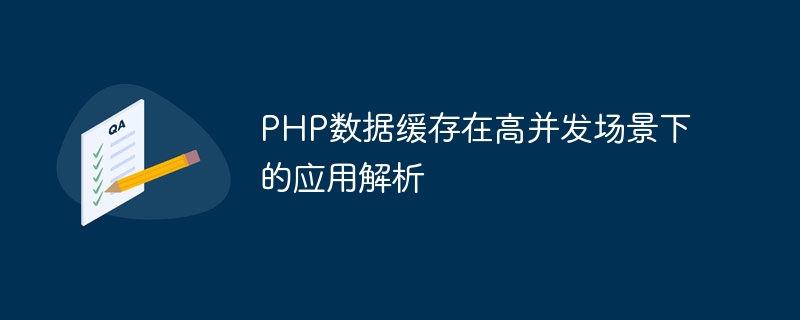Home >Backend Development >PHP Tutorial >Application analysis of PHP data cache in high concurrency scenarios
Application analysis of PHP data cache in high concurrency scenarios
- 王林Original
- 2023-08-10 23:21:441283browse

Application analysis of PHP data caching in high concurrency scenarios
In high concurrency scenarios, PHP data caching is an important part of improving system performance and response speed. By using a caching mechanism, the pressure on the database can be reduced, the data reading time can be shortened, and the system's concurrent processing capabilities can be improved. This article will introduce the concept of PHP data caching and how to apply the caching mechanism in high concurrency scenarios, and provide code examples for analysis.
1. What is PHP data cache?
PHP data caching refers to storing database query results or calculation results in memory, and obtaining data directly from memory during the next query to avoid frequent access to the database or repeated calculations. Through the caching mechanism, the system's response speed and concurrent processing capabilities can be significantly improved.
2. PHP data caching application in high concurrency scenarios
In high concurrency scenarios, the database is usually one of the bottlenecks of the system. Frequent database query and write operations will lead to a decrease in database performance and affect the stability and response speed of the system. By applying the PHP data caching mechanism, some commonly used data can be stored in the cache, thereby reducing the pressure on the database and improving the system's concurrent processing capabilities.
The following is a simple example showing how to use the PHP caching mechanism to improve system performance:
<?php
// 使用memcached作为缓存服务器
$memcached = new Memcached();
$memcached->addServer('localhost', 11211);
// 缓存Key的前缀
$prefix = 'cache_';
function getData($id) {
global $memcached, $prefix;
// 构建缓存Key
$key = $prefix . $id;
// 尝试从缓存中获取数据
$data = $memcached->get($key);
// 如果缓存中有数据,直接返回
if ($data !== false) {
return $data;
}
// 缓存中没有数据,从数据库中获取
$data = fetchDataFromDatabase($id);
// 将数据存入缓存
$memcached->set($key, $data, 60); // 缓存有效期为60秒
return $data;
}
function fetchDataFromDatabase($id) {
// 模拟从数据库中获取数据的操作
// ...
return $data;
}
// 使用缓存获取数据
$id = 1;
$data = getData($id);
// 处理数据
// ...
?>In the above example, by using Memcached as the cache server, we can obtain the data from the database The data is stored in the cache and the cache validity period is set to 60 seconds. The next time you get data, try to get it from the cache first. If the data exists in the cache, return it directly; otherwise, get the data from the database and store it in the cache for subsequent use.
By reasonably setting the cache validity period and cache strategy, we can balance data consistency and cache hit rate according to actual business needs. In high-concurrency scenarios, proper use of the PHP data caching mechanism can effectively improve system performance and response speed. Application caching is a commonly used optimization method.
Summary:
PHP data caching has important application value in high concurrency scenarios. It can reduce the pressure on the database and improve the concurrent processing capabilities of the system. By properly setting the cache policy and cache validity period, we can effectively improve system performance and response speed. However, it should be noted that caching is not a silver bullet and needs to be used rationally and continuously optimized according to actual business needs and system characteristics.
The above is the application analysis and code example of PHP data caching in high concurrency scenarios. I hope this article will be helpful in understanding and applying the PHP data caching mechanism.
The above is the detailed content of Application analysis of PHP data cache in high concurrency scenarios. For more information, please follow other related articles on the PHP Chinese website!

